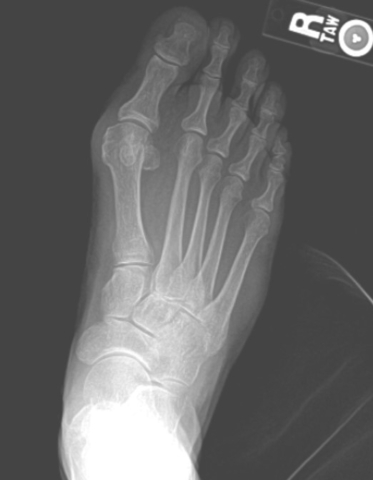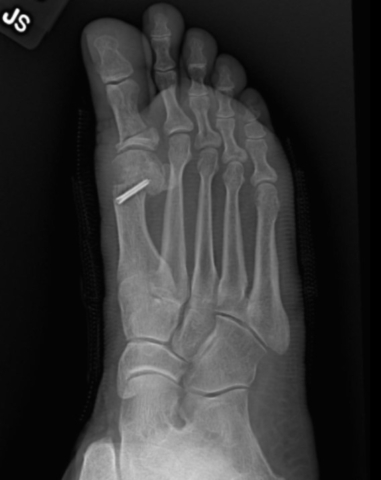Hallux Valgus (Bunion)
The term “hallux valgus” is Latin and means a turning outward (valgus) of the big toe (hallux). The bone which joins the big toe, the first metatarsal, becomes prominent on the inner border of the foot. This bump is the bunion and is made up of bone and soft tissue.
Office Appointments and Telemedicine with Dr. Carreira

You can also book an office appointment or a telemedicine visit by calling Dr. Carreira’s office at 404-355-0743. Book now.
Bunions rarely occur in individuals who do not wear shoes. Once a bunion is present, the deformity of hallux valgus may worsen over time.
The treatment of a bunion depends on level of pain. Since the pain from a bunion is always aggravated by shoe wear, the symptoms will often depend on the type and size of shoes worn. The perception of pain or discomfort however is varied.
Realistically, there are only two ways to treat a bunion; either change the size and shape of the shoe, or the size and shape of the foot. Due to the styles of shoes, it is obviously much easier to change the size and shape of the shoe in the male than the female.
Once a bunion gets to be irritating or painful, and shoe wear is uncomfortable, surgery may be recommended. There are many different surgical procedures that can be performed. The decision to perform one type of surgery or another is based upon the extent and magnitude of the bunion deformity, the presence of arthritis in the big toe joint, and the space between the first and second metatarsals, which is called the intermetatarsal angle.
There are many different types of bunion surgeries that can be performed successfully. The two most commonly performed in Dr. Carreira’s practice – the Chevron and Lapidus bunion correction surgeries – are set out below.
General Facts about Chevron Bunionectomy (Bunion Surgery)
This operation is designed to correct the bunion and the poor alignment of the 1st metatarsal. In order to correct the 1st metatarsal, a bone cut (an osteotomy) is made, and the bone is shifted and held in place with one screw. The screw typically stays in permanently, but it can be removed if it causes any problems.
Following surgery, you will be able to wear shoes more comfortably. Care must still be taken to not wear excessively tight shoes, as we recommend for all people, regardless of whether they have a bunion or not. It will take about 6 weeks for the bone to heal, and swelling will be noted for approximately six months, although it is much less noticeable after the first month.
General recovery facts for Bunion Surgery: Chevron
- Expect moderate pain for approximately 2 – 3 days.
- You are weight-bearing as tolerated in the Darco wedge boot immediately after surgery.
- You may use crutches or a walker if you need support.
- You may drive by about 4 days if it is your left foot, and 7 days if your right foot.
- The foot needs to be bandaged for about 3 – 4 weeks.
- You will not be able to get the foot wet while the foot is bandaged.
- Range of motion is recovered mostly between 4 – 6 weeks.
- You will be able to wear a sneaker type shoe at about 4 – 6 weeks.
- The foot will remain puffy and swollen for 4 – 6 months.
Specific Post Operative Course for Bunion Surgery: Chevron
Day 1 – 5
- Foot wrapped in bulky bandage and surgical shoe.
- Ice, elevate, take pain medication.
- Expect numbness in foot 12 – 24 hours, then moderate pain.
- Bloody drainage through bandage is expected.
- Do not change bandage.
- Do not remove Darco wedge shoe – you may use a postoperative shoe while in bed.
- May drive with caution in surgical shoe – test in a parking lot.
Day 7 – 10
- First follow up in the office. X-rays taken.
- Dressing changed bunion bandaging done.
4 – 6 weeks
- Dressing/strapping changed as needed.
- May start wearing sneaker type shoe.
- Physical therapy usually needed for 1 – 2 months.
- Expect swelling in the foot for about 4 months.
The Lapidus Bunionectomy
This operation is designed to correct the big toe deformity, the bunion, as well as the deviated position of the 1st metatarsal. In order to correct the 1st metatarsal, a bone cut (an osteotomy) is made. The bone cut is fixed with a plate and screws. The plate and screws typically stay in forever, unless you are able to feel it, when it can be removed.
With all types of bunion surgery, you will be able to wear shoes more comfortably. This does not mean however that you will be able to wear narrow tight shoes. It will take about two to three months for the bone to heal before you can exercise, and another 4 – 6 months for all of the swelling in the foot to decrease.
General Recovery Facts for Bunion Surgery: Lapidus
- Expect moderate pain for a few days.
- You are non-weight bearing in a cast or CAM walker for a total of 2 – 6 weeks after surgery, depending on your bone quality as noted at the time of surgery.
- You may use crutches, walker, or a wheeled device if you need support.
- You may drive by about 4 days if it is your left foot, and 2 weeks if it is your right foot. A postoperative shoe will be provided for you if it is your right foot for use while driving only.
- The foot needs to be bandaged for about 3 – 4 weeks.
- You will not be able to get the foot wet while the foot is bandaged.
- You will be able to wear a sneaker type shoe at about 8 weeks.
Specific Post Operative Course for Bunion Surgery: Lapidus
Day 1 – 5
- Foot wrapped in bulky bandage and surgical shoe.
- Ice, elevate, take pain medication.
- Expect numbness in foot 12 – 24 hours, then moderate pain.
- Bloody drainage through bandage is expected.
- Do not change bandage.
- Do not remove splint.
Day 7 – 14
- First follow up in the office. X-rays taken.
- Dressing changed bunion bandaging done.
2 – 6 weeks
- Dressing/strapping changed as needed.
- Non-weight bearing until X-rays confirm bone healing.




